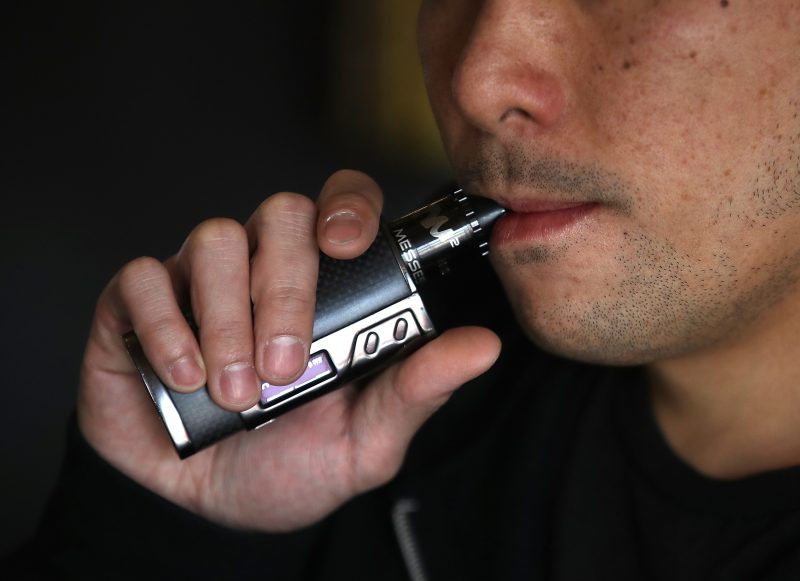Is San Francisco’s vaping ban backed by science?
Jeremy Wong smokes an e-cigarette at The Vaping Buddha on January 23, 2018 in South San Francisco, California (JUSTIN SULLIVAN)
Washington (AFP) – San Francisco has decided to ban the sale of e-cigarettes in 2020, hoping to curb a surge in vaping among adolescents. But is the policy backed up by the available evidence?
– How harmful is vaping? –
Unlike tobacco cigarettes, e-cigarettes do not “burn.” The devices, which have been available in the US since 2006, work instead by heating up a liquid that then turns into vapor and is inhaled.
Because of this, e-cigarette users don’t get exposed to the estimated 7,0000 chemical constituents present in combustible cigarettes, and vaping is generally believed to be safer than smoking.
The liquids do, however, contain nicotine, which has been studied for decades and is known to be highly addictive.
They also contain a variety of other constituents classed as “potentially harmful” according to a 2018 study compiled by the US National Academy of Sciences requested by Congress.
Though many of the flavorings in e-liquids are recognized as safe, their toxicity was studied for oral consumption in food and not inhalation, it said.
There is also “substantial evidence” that the vapor contains traces of metals, either from the coil used to heat the liquid, or other parts of the device.
Another potential red flag, according to the Centers for Disease Control and Prevention is the presence of diacetyl, which is used to add a butter flavoring to microwave popcorn but has been linked to a serious but relatively rare lung disease.
For the time being, there is “no available evidence” to show whether or not e-cigarettes use is associated with cancer, said the NAS report.
But there’s a caveat. While experts generally believe vaping is a less toxic alternative to smoking, “the implications for long-term effects on morbidity and mortality are not yet clear,” and would require decades of more data and studies to know for certain.
– Can it help smokers quit? –
Market leading maker Juul’s response to the San Francisco ban was that it would “drive former adult smokers who successfully switched to vapor products back to deadly cigarettes.”
Are they right about that?
A study published in February in the New England Journal of Medicine on a group of 886 patients in Britain’s National Health Service found the claim to be true.
The one-year abstinence rate among e-cigarette users was 18 percent, compared to 9.9 percent among a group who used other nicotine replacement products like gum or patches.
The conversions are not, however, all in one direction.
A slew of recent studies have found that, among adolescents, e-cigarettes effectively provide a gateway toward full-fledged smoking.
Authorities are worried that decades of declining smoking rates among this demographic could go up in smoke as a result of these devices.
– Regulation versus prohibition –
The vaping industry is adamant it doesn’t want to see underage people using its products and more must be done to prevent their sale. E-cigarettes are already illegal to sell in the US to people under 18 or 21, depending on the state.
But, the sector argues, bans are a poor policy choice because they deprive adults addicted to smoking of a valuable tool.
“To deprive those smokers from access to e-cigarettes, which we know are substantially less harmful, I think is a terrible decision, ” Neil McKeganey, of the UK-based Center for Substance Use Research based, which is partly funded by the industry, told AFP.
The irony is that the sale of alcohol, cigarettes and cannabis will remain legal in San Francisco for those over 21.
The risks associated with all three are well studied. For alcohol, these include liver disease, high blood pressure and heart disease, numerous cancers. For cigarettes, heart disease, stroke, lung and various other cancers.
Numerous papers meanwhile have explored the risks of cannabis particularly on the juvenile brain.
In place of bans, makers want to see tighter regulation.
There is a lot of work to be done: an analysis of Californian vendors published Monday in the medical journal JAMA found that almost half of tobacco and vape shops did not ID young customers looking to buy vape products.
Disclaimer: Validity of the above story is for 7 Days from original date of publishing. Source: AFP.


